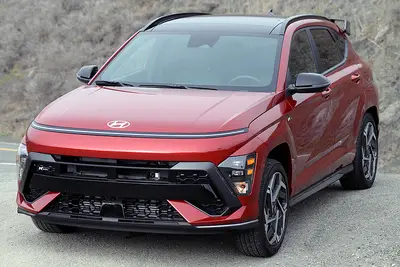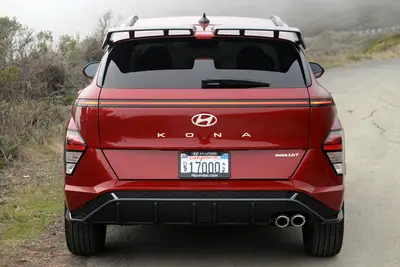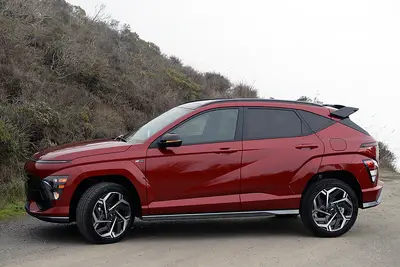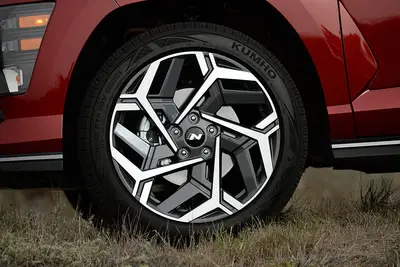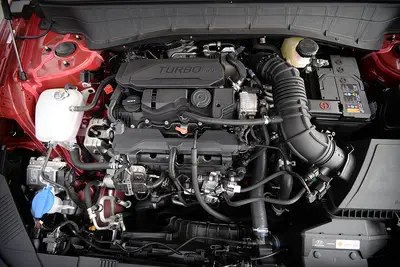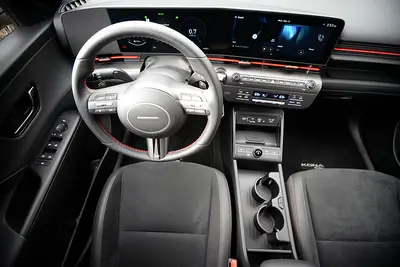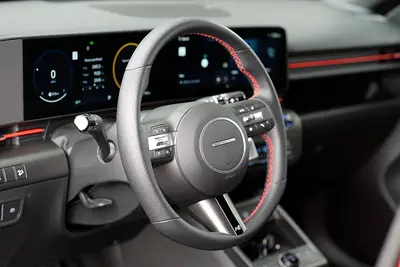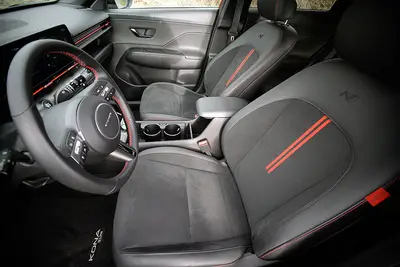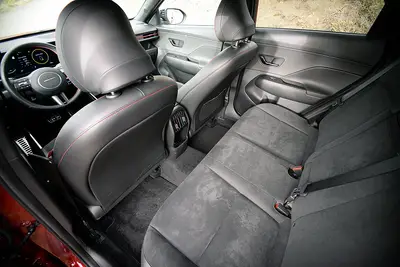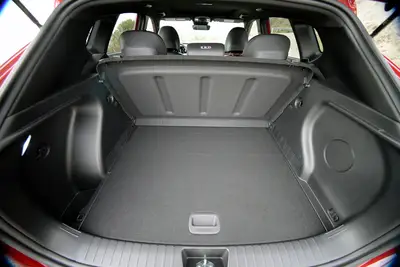2024 Hyundai Kona N Line AWD – Review by David Colman +VIDEO
Kona experiences a growth spurt
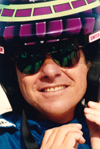 David Colman |
Special Correspondent to THE AUTO CHANNEL
You could say that Hyundai's Kona has finally grown up for 2024. In fact it's grown 8.5 inches in length and 2.7 inches in wheelbase. To give you an idea of what that spurt has done to improve load space, cargo volume behind the rear seat has jumped from 22.5 cubic feet to 26 cubic feet. I discovered that dropping the rear bench seats flat opened up a storage bay large enough to accept my full-size mountain bike. The outgoing Kona would have been hard-pressed to store a tricycle. However, the downside of the added girth is a substantial 305-pound increase in curb weight. That means the new Kona is saddled with the weight of two extra passengers compared to the previous model.
Added space is but one of many revisions to the Kona. A quick gander at its revamped appearance will shock current Kona owners conditioned to stylistic moderation. The new look Kona throws caution to the winds in a frenetic effort to craft a brash new face. The new model supplants the outgoing model's slab sides with much busier side panels. Hyundai stylists joined boxed fender flares to blocky rocker panels, then added a blitz of ziggurat character lines. Our top echelon N Line test model also sported a set of trapezoid alloy N Line rims that matched the free form look of the body. These 19 inch wheels were shod with surprisingly beefy (235/45R19) Kumo Majesty 9 Solus TA91 radials.
One of the drawbacks of the new look is its pancake flat hood. The front edge of the hood sports a nifty illuminated pinstripe. But the redesign precludes seeing the ground from the driver's seat. Consequently I found myself repeatedly parking the Kona 2 feet short of where it needed to be because I couldn't see the pavement. I suppose an owner would eventually get used to parking by Braille, but satisfactory forward vision is missing. Rear vision, however, is surprisingly good.
Hyundai currently offers two engine packages for the Kona. The underpowered base model makes do with a 147hp 2.0 liter inline-4 that takes forever (9.2 seconds) to achieve 60mph from a standing start. Our N Line was equipped with a 1.6 liter inline-4, turbocharged to make 190hp and 195lb.-ft. of torque. This unit snaps off the zero-to-sixty run in a brisk 7.5 seconds and cranks through the quarter mile in 15.8 seconds at 89mph.
Although turbo lag is largely non-existent today, the Kona's power unit shows vestiges of this old bugaboo. Despite the presence of an 8-speed automatic transmission, the turbo never seems happy when trolling at low speeds. Its surges will have your head bobbing to and fro. Otherwise, the Kona engine is a crisp performer. It displays excellent handling chops courtesy of those oversized Kumo radials. Hyundai offers a Sport drive mode that instantly perks up steering feel and adds further refinement by holding the transmission in the gear you've selected. Small paddles at the steering wheel allow you to upshift and downshift manually as needed.
Hyundai, which plans to offer an EV Kona in the near future, has annexed a number of operational features from their Ioniq 5 EV. One of the best is the steering column mounted gear change which requires flip and twist motions to engage Drive and Reverse. Park is achieved by pushing in the end of lever. This system works quite well, and also frees up storage space between the front seats for cup holders and configurable bins.
In fact, if you decide on buying a Kona, you'll definitely want to upgrade to the N Line model because it transforms an otherwise pedestrian interior into a sporty playroom. We loved the spacious cabin design, with red racing striped "Sport Combination Seating Surfaces" which matched the red pin striping across the face of the dash. The red striping also underlined the Kona's "Ultimate Red Metallic" exterior paint, a color Hyundai includes at no extra charge. A pair of adjoining 12.3-inch video screens comprise the instrument panel and the infotainment panel. Both are easy to read and operate, and Hyundai, to their everlasting credit, have retained physical switches and buttons to operate basic necessities like HVAC and light controls. The newest model of the Kona offers a great deal of performance and transport for a comparatively minimal investment.
2024 HYUNDAI KONA N LINE AWD
-
• ENGINE: 1.6 liter inline-4, turbocharged and intercooled, 16-valve, DOHC, aluminum block and head, direct fuel injection
• HORSEPOWER: 190hp@6000rpm
• TORQUE: 195lb.-ft.@1700rpm
• FUEL CONSUMPTION: 24MPG City/29MPG
• Highway PRICE AS TESTED: $33,695
HYPES: Bigger, More Comfy
GRIPES: Low Speed Turbo Lag
STAR RATING: 9 Stars out of 10
© 2023 David E Colman
DAVID E COLMAN
Auto Journalist
Biographic Profile
Dad jumpstarted my automotive career by taking me to the Indy 500 ten years in a row. During that decade he generously bought me a trio of new cars to drive: a C1 Corvette followed by two XKE roadsters. By 1970, I purchased my first new Porsche, a 911S Targa. The Porsche immersion has continued with a succession of newer models: 1970 914-6GT, 1983 944, 1987 944T, 2003 911 Turbo X50 Aerokit, 2011 911 GT3 RS and 2016 Cayman GT4. This "buy your own press fleet" exposure helped launch my literary career when I co-founded Excellence Magazine in 1987. I have written hundreds of reviews and profiles for Excellence over the past three decades.
I also covered motorsports for The Wheel, SCCA's San Francisco Region newspaper, as well as racing events for the Marin Independent Journal. Other outlets over the years have been The San Francisco Chronicle, Autoweek, Bimmer, Forza and Sports Car International. I started a weekly new car review in 1986 at the Marin IJ and subsequently continued it with the San Francisco Examiner. I am currently a Senior Writer for Vintage Motorsports magazine, and have written numerous race reports and feature articles for that publication.
My weekly reviews first hit the internet at CarReview.com and play today only on TheAutoChannel.com. I was a co-founder of the Western Automotive Journalists (WAJ), a press group formed to track-test vehicles at local road racing circuits. Since 1986, I have driven and evaluated a manufacturer-provided new vehicle just about every week of every year.
I have also been a long time competitor in Porsche Club and SCCA track and autocross events. I was sponsored by BF Goodrich tires for a number of years, and later by Yokohama Tires. My record book at the SCCA's annual Solo 2 National Championship event shows ten consecutive years of entries and trophy successes in a variety of classes. I also earned Top Time of Day at the Porsche Club of America's annual Parade Driving Event in my one owner 914-6GT.
I learned to write proper English in Sidney Eaton's English class at the Noble and Greenough School in Dedham, Massachusetts. Later, I majored in American Literature at Middlebury College (AB) and subsequently earned two Master of Art Degrees from the University of California: English (UC Santa Barbara); History of Art (UC Berkeley). So I'm a pump jockey and a word jockey.



